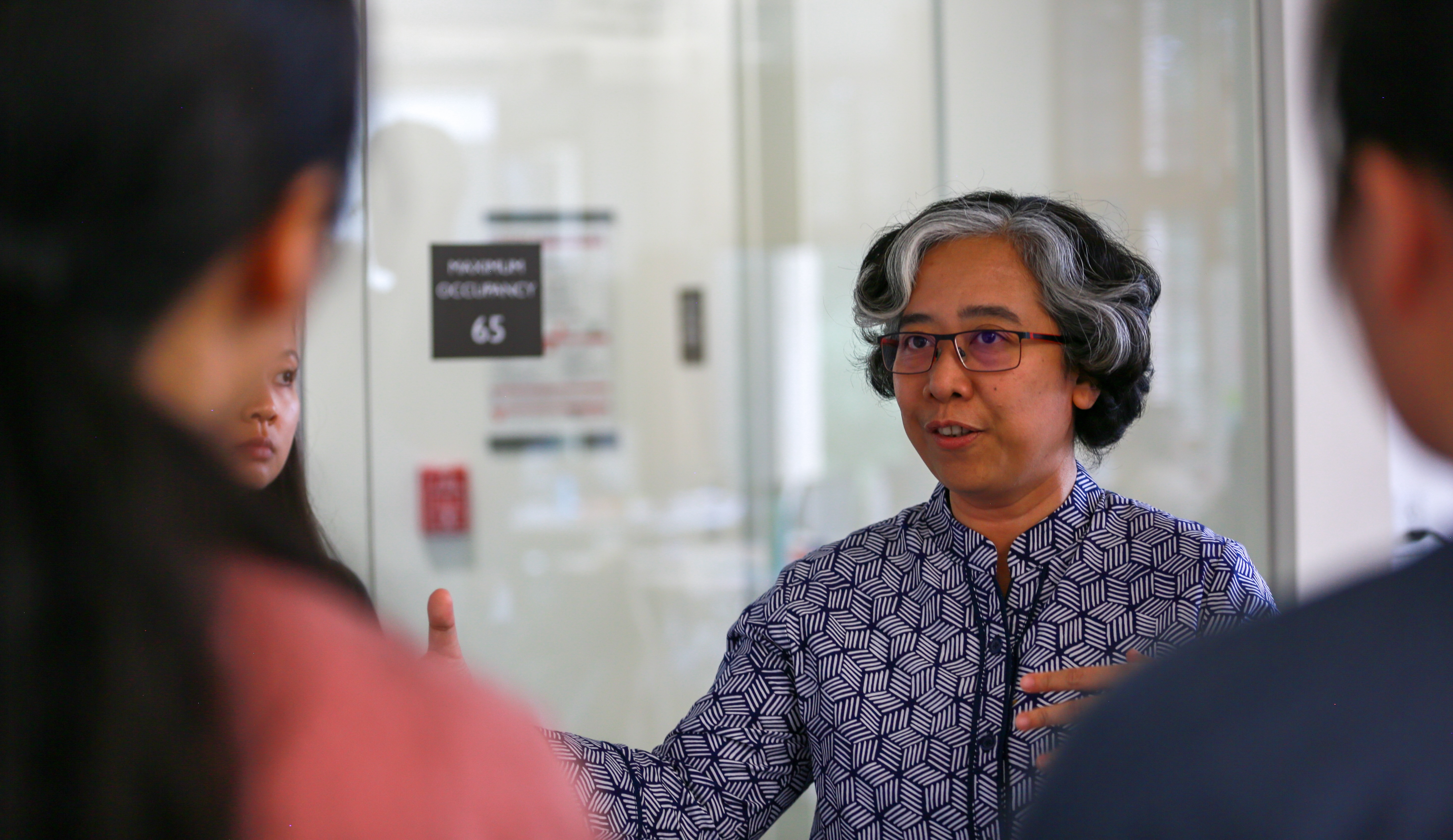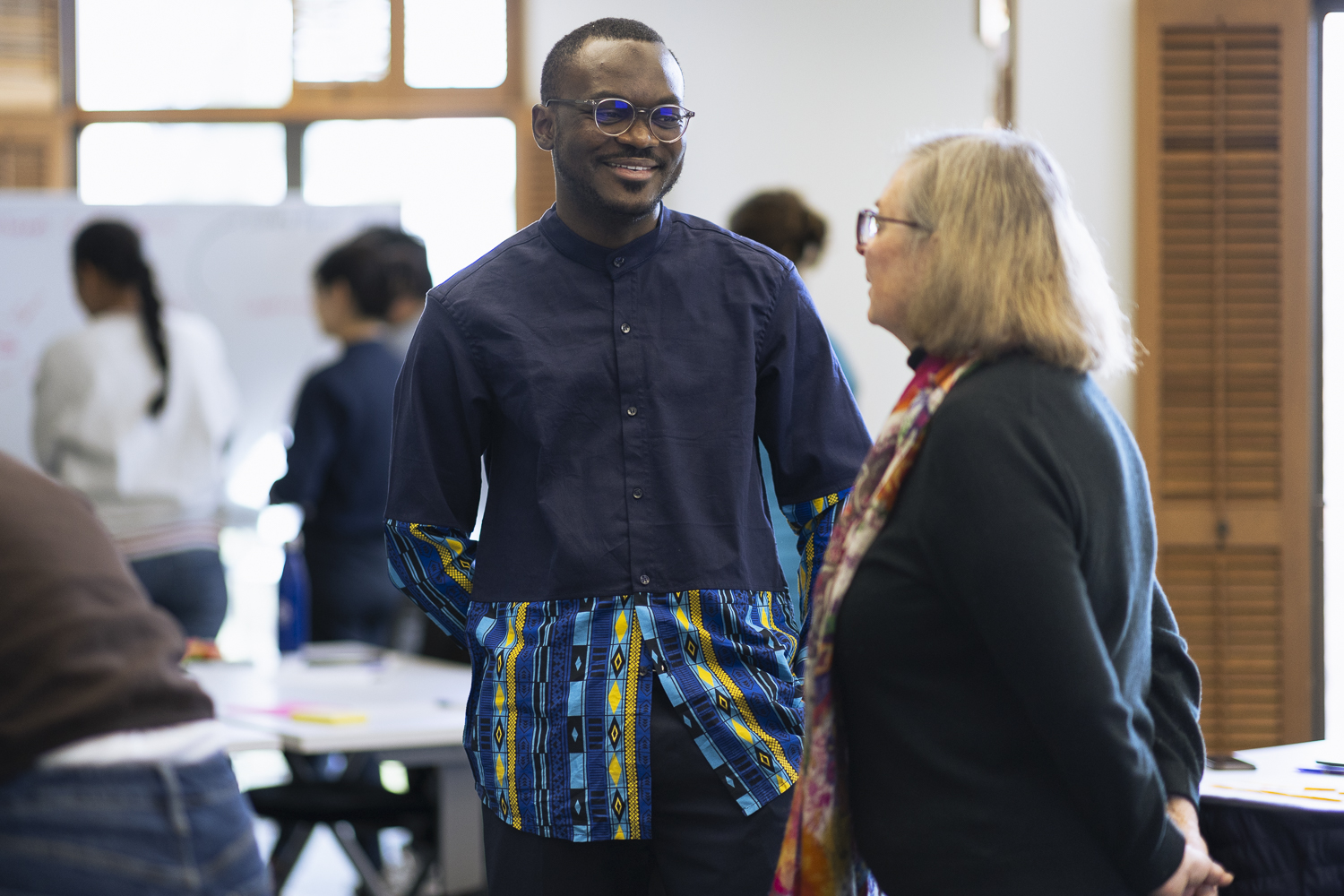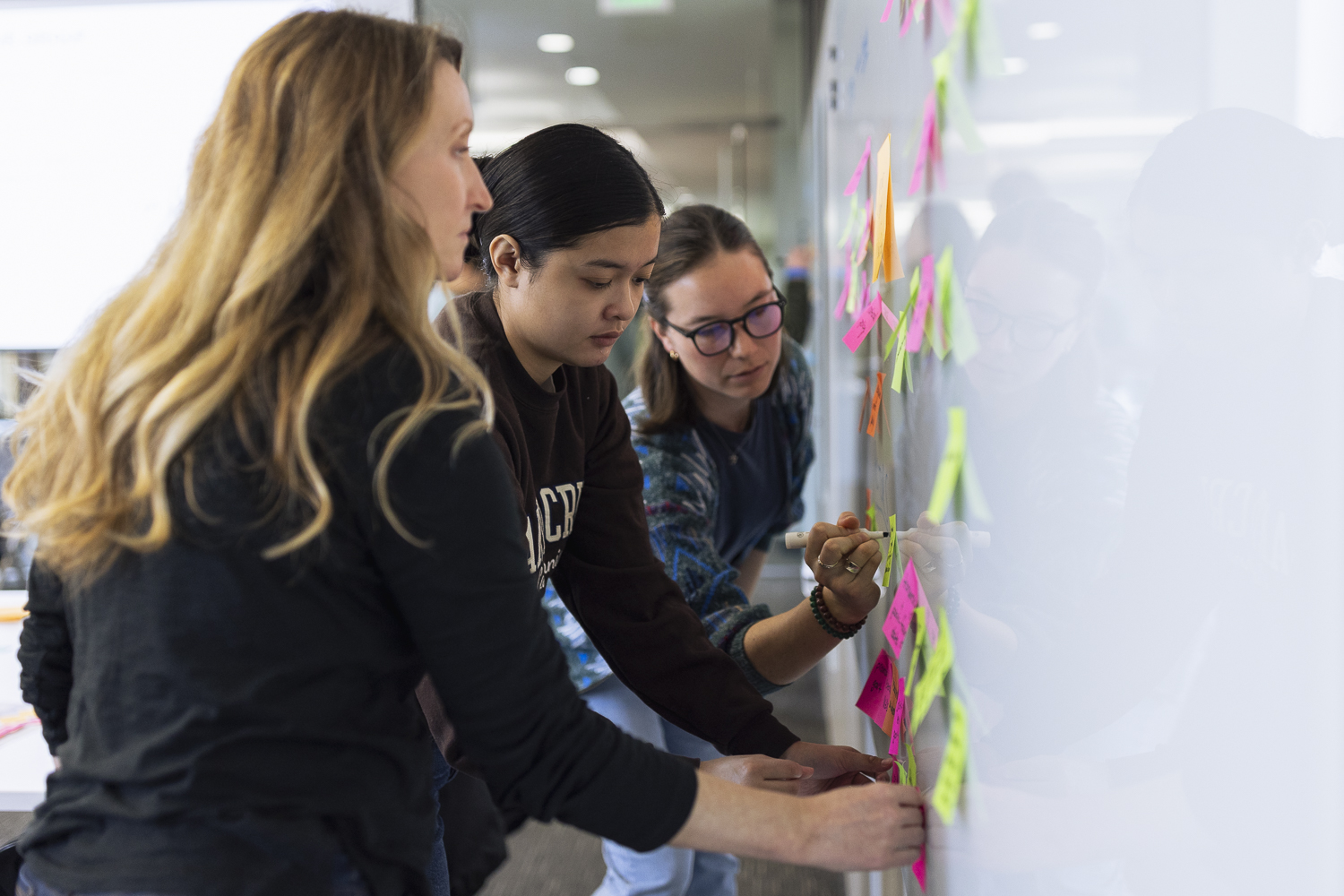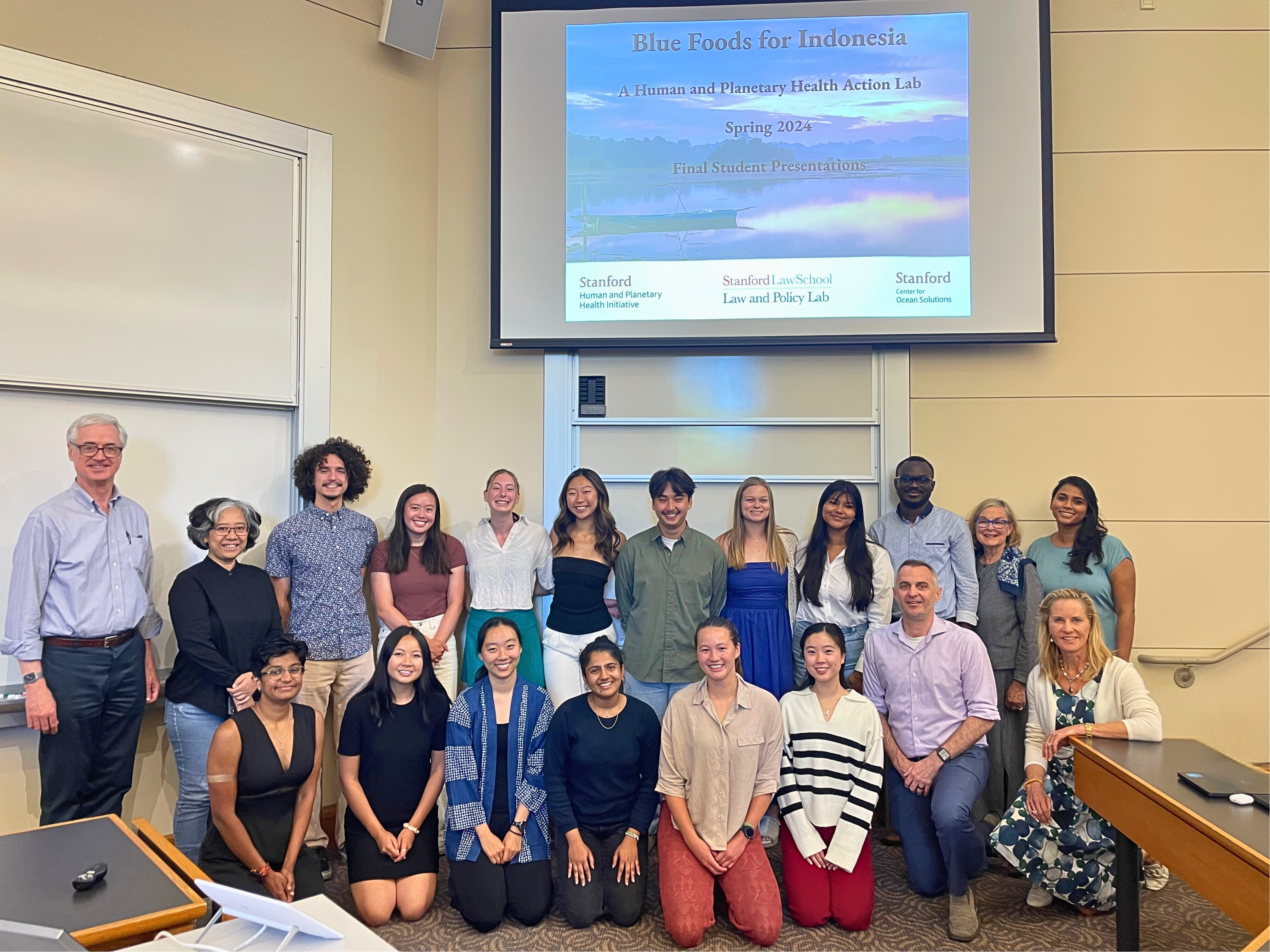Late one evening in mid-March, while many students filtered into dining halls for dinner, students in the course Blue Foods for Indonesia: A Human & Planetary Health Action Lab gathered in a Stanford Law School lecture hall for their final presentations. Students were from across campus, including the sustainability, law, and business schools. Their audience spanned time zones. For these presentations, the group was joined through Zoom by ministry and NGO representatives from Indonesia.
Structured as two courses during winter and spring quarters, small student groups developed policy reports with the goal of informing government decisions about how to incorporate fisheries and aquaculture into Indonesia’s national development strategy over the next two decades.
As the world's largest archipelagic country with the most marine biodiversity on the planet, Indonesia depends on ocean and inland waters to support its food security and economy, as well as the livelihoods of Indonesians.
“I felt contagiously excited at the end of the class,” reflected Kaylee Shen ’25, who is majoring in Earth systems. “I hadn’t realized how complex it could be to synthesize information and present it to policymakers, especially for topics like food systems.”
The Stanford Center for Ocean Solutions led the teaching and development of the interdisciplinary course, which was offered through the Law School and the Stanford Doerr School of Sustainability. The Woods Institute for the Environment’s Human and Planetary Health Initiative and the Law School’s Law and Policy Lab provided additional support.
During the course, students researched fisheries and aquaculture, or “blue food,” topics of interest to the Indonesian Ministry of National Development Planning, known as BAPPENAS. They created reports on subjects including gender equity in the blue food sector, opportunities to implement new innovations such as aquaculture feeds with more sustainably sourced feed ingredients, and the potential of blue foods to address nutritional challenges. The reports included scientific findings and examples of how other countries have approached blue food issues, offering policy choices that could be relevant for Indonesia.
“From the outset of the course, we emphasized an important perspective: When collaborating with the Indonesian government, Stanford's role isn't to offer a single solution,” said Dian Rositawati, a visiting scholar at the Center for Ocean Solutions who has helped implement judicial reform in Indonesia for more than two decades. “The students need to understand what Indonesia needs, but they don’t need to be experts on the country itself. Those experts are the individuals working on the ground or within the government.”
Students share some course takeaways. | Katie Jewett and Madison Pobis
Building trust over time
Blue Foods for Indonesia emerged from the Center for Ocean Solutions’ ongoing blue foods research and collaboration with Indonesian colleagues.
In 2021, a United Nations Food Systems Summit attracted international attention to the potential of blue foods. This was in part due to insights and evidence provided by the Stanford-led Blue Food Assessment, a global research initiative on the role of blue foods in global food systems. The summit and the Blue Food Assessment caught the attention of BAPPENAS, too. In 2023, following discussions among Center for Ocean Solutions staff, ministry representatives, and partner organizations in Indonesia, BAPPENAS launched a collaborative "Blue Food Assessment for Indonesia.”
“The ministry team is looking to our staff for research that can help them make the most of their blue food resources,” said Center for Ocean Solutions co-director Jim Leape, who has worked with colleagues in Indonesia for over 20 years. “For example, having robust information about the nutrients available in Indonesia’s fisheries can help the government make better decisions about how to allocate access to those fisheries, which fish are exported, and which are kept for domestic consumption.”
The 2023 collaboration presented a timely opportunity to involve students in the research effort. In addition to the teaching team working with BAPPENAS to identify research topics of interest, Belva Widyaprasetia, who is supporting BAPPENAS’ development strategy process, joined the winter quarter cohort in person to share perspectives and input from the national planning team.
“What was exciting about the course is that, while our researchers are working with Indonesian colleagues on the Blue Food Assessment for Indonesia, student teams supplement the research shared with BAPPENAS by providing additional case studies and other references for consideration,” said Center for Ocean Solutions research development manager Eric Hartge.

Rositawati speaks with students during a class session. "I want the students to learn not only the content of policy areas but also to develop skills in collaboration, synthesis, and communication. Those skills are crucial for working in policy," she said. | Katie Jewett
Stanford Law School’s Law and Policy Lab provided a dynamic structure for the course, building upon previous collaborations with the Center for Ocean Solutions. Leape, who is also a professor, by courtesy, of oceans in the Stanford Doerr School of Sustainability, and SLS senior lecturer in law (emerita) Jan Martinez co-led a series of Outlaw Ocean Policy Practicums in 2020 and 2021 focused on illegal fishing and labor abuses in the seafood industry. “Policy labs are a microcosm of the public policy process,” said Martinez, who is part of the Blue Foods for Indonesia teaching team. “Ocean challenges can be highly complex, and the practicum structure enables students to work across disciplines, honing their skills in interviewing, research, synthesis, and collaboration.”
“Trust between the Center for Ocean Solutions and BAPPENAS enabled us to understand how the students could help. The students know the client is real and the time and knowledge they bring to the class can genuinely benefit BAPPENAS’ planning,” said Rositawati.
Law and Policy Lab practicums
For over a decade, the Stanford Law School’s Law and Policy Lab has offered students across the university hands-on public policy practicum courses, which enable students to apply research and assessment skills they learn in class to a real-world environment. As with Blue Foods for Indonesia, some past courses have involved international and government clients.
According to faculty director Paul Brest, courses are structured around the needs of a policy client with a specific problem they wish to address. “Faculty across the university have extensive connections with non-profits, governments, advocacy groups, and other potential practicum clients,” said Brest. “These practicums serve as an ideal opportunity to harness Stanford's resources and research expertise to make a meaningful impact through collaborations both locally and globally.”
Learning public policy approaches
The winter and spring quarter courses incorporated presentations from blue food experts to familiarize students with the state of the field. Once they learned about the issues broadly, students were divided into small teams that focused on thematic areas determined by the teaching team in consultation with BAPPENAS and other Indonesian collaborators. During the winter quarter, these areas were small-scale fisheries, justice, tech innovation, and aquaculture.

Martinez talking with fellow teaching team member Richard Nyiawung, Center for Ocean Solutions human and planetary health postdoctoral scholar. “One of the hardest things about policy labs is to get students’ knowledge of the foundational issues from zero to sixty in a week so they can do something useful,” said Martinez. | Andrew Brodhead
“The student groups gathered case studies to demonstrate different ways of approaching policy decisions,” said Richard Nyiawung, the human and planetary health postdoctoral scholar at the Center for Ocean Solutions and a teaching team member. “They proposed different scenarios for consideration; they didn’t prescribe policy solutions.”

The justice team gathers ideas during a class session. "Gender equity considerations are often overlooked in the blue food sector. Learning from experts in the field last quarter has really shaped how I am now approaching my research on small-scale fisheries," said Quinn Parker (right), a PhD student in the Oceans Department at the Stanford Doerr School of Sustainability. Parker is joined by Camille Effler (left), a PhD student in the Emmett Interdisciplinary Program in Environment and Resources, and Mikaela Linda Salvador (center), a Master's student in Earth System Science, also in the Stanford Doerr School of Sustainability. | Andrew Brodhead
Reflecting on his experience as part of the winter quarter tech innovation team, Graduate School of Business Sloan Fellow Jinho Clement said, “I’ve done policy work back home in Malaysia, and what we often don’t do enough in policy is have candid, one-on-one interviews with a broad variety of practitioners in the field. Our group interviewed over 30 experts, and I saw how powerful a well-curated, systematic, interview-based approach can be in deeply understanding complex challenges.”
For example, as part of that tech innovation research, the team identified cases where governments had provided physical space to test new technologies. In Hawai'i, for instance, the State has invested in the Hawaii Ocean Science and Technology Park, an outdoor demonstration site for emerging renewable energy, aquaculture, and other ocean-based sustainable technologies. The team offered a range of such models from six countries in their final report.
Martinez stressed the importance of teaching students to step back from an issue, comprehend the components of a challenge, and acknowledge their role and expertise in a policy space. These skills are crucial for preparing students for future interdisciplinary work, she said.
“This course has encouraged students to always consider the context,” said Nyiawung. “Their research drew from existing literature and interviews with diverse experts and actors. This complementary approach strengthens both the science and its contributions to policy processes.”

The spring cohort of Blue Foods for Indonesia students after final presentations. | Katie Jewett
On June 4, Blue Foods for Indonesia students once again gathered for presentations. The spring cohort shared their findings about research topics that built on winter quarter themes as well as new areas of exploration. The student reports from both quarters will be shared with BAPPENAS and will contribute to the Blue Food Assessment for Indonesia. Together, the wealth of insights produced by the students in collaboration with their Indonesian colleagues exemplifies how academic researchers can contribute to a country's policy process effectively and respectfully.
"It was impressive to see how energized the students were in class and while presenting their reports,” said Widyaprasetia. “Their dedication and contributions to the project will help us shape a research-based development plan.”